Logic Pro X User Guide
- Welcome
-
- What is Logic Pro?
- Workflow overview
- Logic Pro project basics
- Advanced tools and additional options
- Undo and redo edits
- Manage Logic Pro content
- How to get help
-
- Projects overview
- Create projects
- Open projects
- Save projects
- Delete projects
-
- Play a project
- Set the playhead position
- Control playback with the transport buttons
- Use transport shortcut menus
- Use transport keyboard shortcuts
- Customize the control bar
- Change the LCD display mode
- Monitor and reset MIDI events
- Use the cycle area
- Use the Chase Events function
- Control Logic Pro using Apple Remote
- Control Logic Pro projects using Logic Remote
- Preview projects in the Finder
- Close projects
- View project information
-
- Overview
-
- Before recording software instruments
- Play software instruments
- Record software instruments
- Record additional software instrument takes
- Overdub software instrument recordings
- Spot erase software instrument recordings
- Use Note Repeat
- Record to multiple software instrument tracks
- Replace software instrument recordings
- Record multiple MIDI devices to multiple tracks
- Record software instruments and audio simultaneously
- Use step input recording techniques
- Use the metronome
-
- Overview
-
- Regions overview
- Select regions
- Select parts of regions
- Cut, copy, and paste regions
- Move regions
- Add or remove gaps
- Delay region playback
- Loop regions
- Repeat regions
- Resize regions
- Mute and solo regions
- Time stretch regions
- Split regions
- Demix MIDI regions
- Join regions
- Create regions in the Tracks area
- Normalize audio regions in the Tracks area
- Create aliases of MIDI regions
- Clone audio regions
- Change the color of regions
- Convert audio regions to Sampler sample zones
- Rename regions
- Delete regions
-
- Overview
-
- Add notes
- Select notes
- Snap items to the grid
- Move notes
- Copy notes
- Change the pitch of notes
- Resize notes
- Edit note velocity
- Quantize the timing of notes
- Quantize the pitch of notes
- Change note articulations
- Lock the position of events
- Mute notes
- Change note color
- View note labels
- Delete notes
- Time stretch notes
- View multiple MIDI regions
- Split chords
- Automation/MIDI area in the Piano Roll Editor
- Open other editors
-
- Flex Time and Pitch overview
-
- Flex Pitch algorithm and parameters
- Edit the pitch of audio in the Audio Track Editor or a zoomed in track
- Edit the pitch of audio in the Tracks area when the track is not zoomed in
- Correct the timing of audio regions with Flex Pitch
- Quantize the pitch of audio regions
- Create MIDI from audio recordings
- Change the gain of audio regions
- Use Varispeed to alter the speed and pitch of audio
-
- Mixing overview
- Set channel strip input formats
- Set channel strip pan or balance positions
- Mute and solo channel strips
-
- Plug-ins overview
- Add, remove, move, and copy plug-ins
- Insert a plug-in on a track using drag and drop
- Activate plug-ins on inactive channels
- Use the Channel EQ
- Work in the plug-in window
- Work with plug-in settings
- Work with plug-in latencies
- Work with Audio Units plug-ins
- Support for ARA 2 compatible plug-ins
- Use the Plug-in Manager
- Work with channel strip settings
- Surround panning
- Use the I/O Labels window
- Undo and redo Mixer and plug-in adjustments
-
- Smart Controls overview
- Show Smart Controls for master effects
- Choose a Smart Control layout
- Automatic MIDI controller assignment
- Map screen controls automatically
- Map screen controls
- Edit mapping parameters
- Use parameter mapping graphs
- Open the plug-in window for a screen control
- Rename a screen control
- Use articulation IDs to change articulations
- Assign hardware controls to screen controls
- Compare Smart Control edits with saved settings in Logic Pro
- Use the Arpeggiator
- Automate screen control movements
-
- Live Loops overview
- Start and stop cells
- Work with Live Loops cells
- Change loop settings for cells
- How the Live Loops grid and Tracks area interact
- Edit cells
- Edit scenes
- Work in the Cell Editor
- Record a Live Loops performance
- Change Live Loops grid settings
- Control Live Loops in Logic Pro with other devices
-
- Overview
- Add notes
-
- Part box overview
- View score symbols
- Select score symbols
- Add notes and rests
- Add notes and symbols to multiple Logic Pro regions
- Add key and time signature changes
- Change the clef sign
- Add dynamic marks, slurs, and crescendi
- Change note heads
- Add symbols to notes
- Add trills, ornaments, and tremolo symbols
- Add sustain pedal markings
- Add chord symbols
- Add chord grids and tablature symbols
- Add bar lines, repeats, and coda signs
- Add page and line break symbols
-
- Select notes
- Move and copy notes
- Change note pitch, duration, and velocity
- Change note articulations
- Quantize the timing of notes
- Restrict note input to the current key
- Control how ties are displayed
- Add and edit tuplets
- Override display quantization using tuplets
- Add grace notes and independent notes
- Delete notes
- Use automation in the Score Editor
-
- Staff styles overview
- Assign staff styles to tracks
- Staff Style window
- Create and duplicate staff styles
- Edit staff styles
- Edit staff, voice, and assign parameters
- Add and delete staffs or voices in the Logic Pro Staff Style window
- Copy staffs or voices in the Logic Pro Staff Style window
- Copy staff styles between projects
- Delete staff styles
- Assign notes to voices and staffs
- Display polyphonic parts on separate staffs
- Change the staff assignment of score symbols
- Beam notes across staffs
- Use mapped staff styles for drum notation
- Predefined staff styles
- Share a score
-
- Environment overview
- Common object parameters
- Customize the Environment
-
-
- Fader objects overview
- Use fader objects
- Play back fader movements
- Work with object groups
- Fader styles
- Fader functions: MIDI events
- Fader functions: range, value as
- Fader functions: filter
- Vector fader
- Special faders overview
- Cable switchers
- Meta event faders
- SysEx faders
- Work with SysEx messages
- Special functions
- Ornament objects
- MMC record buttons
- Keyboard objects
- Monitor objects
- Channel splitter object
- Physical input objects
- Physical input objects
- MIDI click objects
-
-
- Key commands overview
- Browse, import, and save key commands
- Assign key commands
- Copy and print key commands
-
- Global Commands key commands
- Global Control Surfaces Commands
- Various windows
- Windows Showing Audio files
- Main Window Tracks and Various Editors
- Live Loops Grid
- Various Editors
- Views showing Time Ruler
- Main Window Tracks
- Mixer
- MIDI Environment
- Piano Roll
- Score Editor
- Event Editor
- Step Editor
- Step Sequencer
- Project Audio
- Audio File Editor
- Smart Tempo Editor
- Sampler
- Step Input Keyboard
- Tool key commands in Logic Pro
- Touch Bar shortcuts
-
-
- Working with your control surface
- Connect control surfaces
- Add a control surface to Logic Pro
- Automatic assignment for USB MIDI controllers
- Grouping control surfaces
- Control Surfaces preferences overview
- Modal dialog display
- Tips for using your control surface
- Control surfaces supported by Logic Pro
- Software and firmware
-
-
- Learn about Effects
-
- Learn about Amps and Pedals
-
- Bass Amp Designer overview
- Bass amplifier models
- Bass cabinet models
- Build a custom combo
- Amplifier signal flow
- Pre-amp signal flow
- Use the D.I. box
- Amplifier controls
- Bass Amp Designer effects overview
- Bass Amp Designer EQ
- Bass Amp Designer compressor
- Bass Amp Designer Graphic EQ
- Bass Amp Designer Parametric EQ
- Bass Amp Designer microphone controls
-
- Use MIDI plug-ins
-
- Arpeggiator overview
- Arpeggiator control parameters
- Note order parameters overview
- Note order variations
- Note order inversions
- Arpeggiator pattern parameters overview
- Use Live mode
- Use Grid mode
- Arpeggiator options parameters
- Arpeggiator keyboard parameters
- Use keyboard parameters
- Assign controller parameters
- Modifier MIDI plug-in controls
- Note Repeater MIDI plug-in controls
- Randomizer MIDI plug-in controls
-
- Use the Scripter MIDI plug-in
- Use the Script Editor
- Scripter API overview
- MIDI processing functions overview
- HandleMIDI function
- ProcessMIDI function
- GetParameter function
- SetParameter function
- ParameterChanged function
- Reset function
- JavaScript objects overview
- Use the JavaScript Event object
- Use the JavaScript TimingInfo object
- Use the Trace object
- Use the MIDI event beatPos property
- Use the JavaScript MIDI object
- Create Scripter controls
- Transposer MIDI plug-in controls
-
- Learn about included Instruments
-
- Alchemy overview
- Name bar
-
- Alchemy source overview
- Source master controls
- Import browser
- Source subpage controls
- Source filter controls
- Source filter use tips
- Source elements overview
- Additive element controls
- Additive element effects
- Spectral element controls
- Spectral element effects
- Pitch correction controls
- Formant filter controls
- Granular element controls
- Sampler element controls
- VA element controls
- Source modulations
- Morph controls
- Master voice section
- Alchemy extended parameters
-
- Logic Pro Quick Sampler overview
- Add content to Logic Pro Quick Sampler
- Logic Pro Quick Sampler waveform display
- Use Flex in Logic Pro Quick Sampler
- Logic Pro Quick Sampler Pitch controls
- Logic Pro Quick Sampler Filter controls
- Quick Sampler filter types
- Logic Pro Quick Sampler Amp controls
- Logic Pro Quick Sampler extended parameters
-
- Sculpture overview
- Sculpture interface
- Global parameters
- Amplitude envelope parameters
- Use the Waveshaper
- Filter parameters
- Output parameters
- Use surround range and diversity
- Assign MIDI controllers
- Extended parameters
-
-
- Ultrabeat overview
- Ultrabeat interface
- Synthesizer section overview
- Filter section controls
- Distortion circuit controls
- Glossary

Create snare drums in Logic Pro Ultrabeat
The sound of an acoustic snare drum consists primarily of two sound components: the sound of the drum itself and the buzzing of the snare springs. Try to approximate this combination in Ultrabeat with a single oscillator and the noise generator. Follow the tutorials sequentially to get the most from these examples.
Create a basic snare drum
In Logic Pro X, load the Standard Tutorial setting.Turn off oscillator 1, and turn on oscillator 2 (in phase oscillator mode).
Choose LFO 1 from the mod pop-up menu of Osc 2 Pitch.
Set the pitch value for Osc 2 to around G#2 and set the Mod amount (the blue Mod control) to about 3 to 4 octaves higher.
You have modulated Osc 2 Pitch with a rapidly vibrating LFO with a medium Ramp Decay value. This eliminates the sine wave—which is not especially desirable for a snare sound, in contrast to the bass drum.
Set LFO 1 to a high Rate. Choose a value of 20 for Cycles and −20 for Ramp. Set the LFO Waveform parameter to a value of about 0.58, which is a square wave.
Use Env 1 to control the volume of oscillator 2 by setting Vol to the lowest possible value (−60 dB), choosing Env 1 from the mod pop-up menu, and adjusting the modulation intensity to a point just below its maximum value.
The figure shows the settings of oscillator 2 and Env 1.

Experiment with different Slope and Asym values to impart a more or less electronic character to the sound.
Turn on the noise generator and control its volume with the same quick envelope used in Osc 2 Volume.
Use the filter parameters of the noise generator to roughen up, refine, or add bright frequencies to the noise component of the snare drum sound. Select an LP filter type, and try a filter frequency between 0.60 and 0.90. Modulate it with LFO 1, which you’re already using to control the pitch of oscillator 2.
Note: The snare drum sound is listed as “snare 1” in the Tutorial Kit, at a pitch of E1.
Refine the snare drum sound using FM synthesis
In Logic Pro X, turn on oscillator 1 in FM mode. Use Env 1 to control the volume of Osc 1 as well.
Choose a pitch for oscillator 1 that’s about an octave lower than oscillator 2. Consciously avoid even intervals between the oscillators and detune them slightly from each other. For example, try a pitch setting of F#2 in Osc 2 and E1 in Osc 1, then fine-tune Osc 1 a few cents higher by holding down Shift while adjusting the Osc 1 Pitch slider.
Experiment with FM Amount, and add more tone (low FM Amount) or noise (more FM Amount) as desired. Also try modulating the FM Amount with a fast LFO.
Higher FM Amount values lead to considerably more overtones and a very electronic sound character. If you want to make the sound more acoustic, feed oscillator 1 (and possibly oscillator 2 as well) into the main filter. Use these settings to start: LP 24 mode and a Cutoff value of about 0.60.
Note: An exemplary snare drum sound that uses FM can be found in the Tutorial Kit at a pitch of F1. It is listed as “snare 2.”
Recreate the 808 snare sound
The famous 808 snare is based on two resonating filters and a noise generator, fed through a highpass filter. The mix ratio of the two filters and the volume of the noise generator can be adjusted. This structure cannot be 100% replicated in Ultrabeat.
In Logic Pro X, load the Standard Tutorial setting.
You are now ready to replicate the resonating filters of the 808 snare using two cleverly programmed phase oscillators.
Assign slightly different Slope values to two phase oscillators, and detune them by almost an octave.
Adjust the tonal relationship between the oscillators so that it is uneven—from E3 to F2, for example.
Control the volume of each oscillator with a different envelope. Adjust the decay times so that the envelope for the lower-tuned oscillator has a longer decay time than the very snappy envelope setting for the higher oscillator.
Feed the output of both oscillators into the main filter, and hollow out the sound with a highpass filter. Activate the filter bypass button in both oscillators. Choose the HP 12 setting in the filter, a Cutoff value around 0.40, and a Resonance value of about 0.70.
You have just cleverly emulated both of the TR-808 resonating filters. Shifting the pitch of both oscillators simulates the behavior of the TR-808 Tone control.
Complete the 808 emulation by adding some noise
In Logic Pro X, switch the noise generator on, and activate the highpass mode in its filter (HP).
Set the Cutoff value to about 0.65, Resonance to 0.35, and add a little Dirt (around 0.06).
The noise generator provides the sustained snare sound. It should be shaped by its own envelope—independent of the decay phases of both oscillators—to get 808-like results. Changing the volume of the noise generator simulates the snap parameter of the 808.
Note: The 808 snare drum described is listed as “snare 3-808” in the Tutorial Kit, at a pitch of F#1. It also features an interesting EQ setting.
Use velocity modulation on your 808 snare
Use the 808 snare drum sounds in the Tutorial Kit to explore the possibilities Ultrabeat offers for implementing velocity.
In Logic Pro X, select the “snare 3-808” sound.
Choose Vel from the via pop-up menu below the oscillator 1 Volume knob.
A slider appears on the ring around the knob.
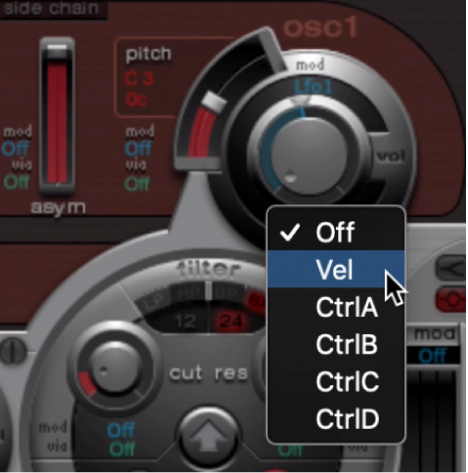
Drag the slider clockwise. When you drag the slider, a help tag displays the value. Set it to 0 dB.
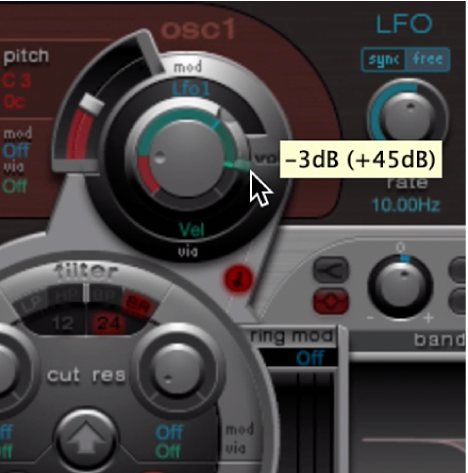
Repeat steps 2 and 3 in both oscillator 2 and the noise generator.
You can now dynamically play the sound using velocity.
Increase the performance dynamics of your 808 snare
In Logic Pro X, reduce the values of the individual volumes by turning down the Volume knobs in both oscillators and the noise generator. Note how the mod ring and its via sliders also move back. Change the via slider positions until all three Volume knobs look like this:
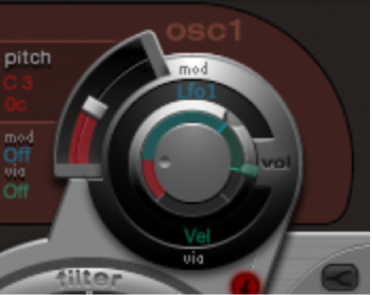
If you use differing intensities for each Volume knob when completing this step, you’ll have the potential of individual velocity reactions for each sound component.
Increase the dynamics of the sound as a whole by assigning the following setting to the Voice Volume knob:
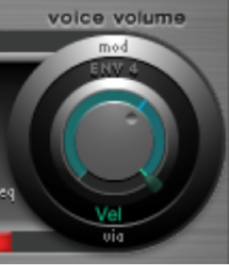
You now have an 808 snare that is exceptionally responsive to velocity. As you may know, this wasn’t possible with the original—not even an 808 sample could offer the dynamic volume control of individual sound components demonstrated here. A sample offers you only the whole sound, not its constituent parts.
In the next step, you use velocity to control the character of the sound—individually for each component—plus volume, of course.
Choose Max from the saturation mod pop-up menu of oscillator 2, and then choose Vel(ocity) from the corresponding via pop-up menu.
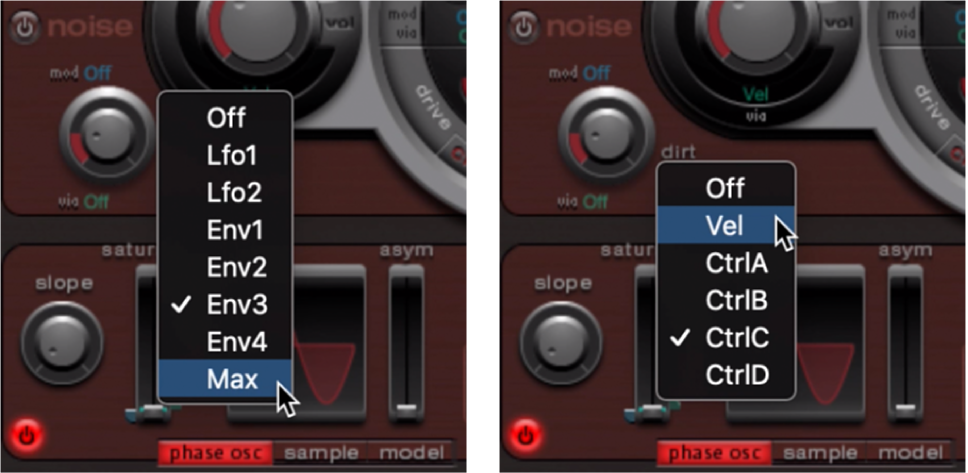
Set the additional control that appears as shown in the figure below, to control the character of the sound with velocity:
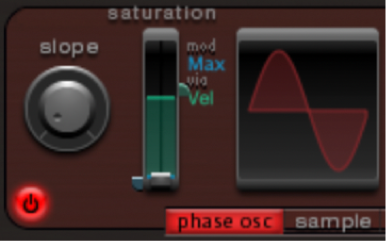
Repeat this with the other parameters of oscillator 2, as well as pitch:

Modulate the noise generator as follows:
Cut parameter: Choose Max as modulation source, then set the modulation control as shown below.
Dirt parameter: Choose LFO 2 as modulation source, then set the modulation control as shown below.

The sound is now nothing like an 808 snare, which was your goal. Keep experimenting with velocity and figure out when it makes sense to use it as a direct or indirect modulation source, in either its positive or negative form.
Recreate the Kraftwerk snare sound
Another classic electronic snare drum sound is the highly resonant lowpass filter of an analog synthesizer that quickly closes with a snap. This sound was used extensively by Kraftwerk.
In Logic Pro X, select the Snare 1 sound.
Direct the signals of both oscillators and the noise generator to the main filter.
Modulate Cutoff with Env 1 (which is already modulating the volume of the noise generator).
Modulate the filter resonance with Env 2.
Experiment with the parameters mentioned in steps 2 to 4 (especially the envelopes), introduce EQ into the sound, and discover how much “playing room” these basic settings allow you.
Note: An exemplary sound is listed as “snare 5-KW” in the Tutorial Kit, at a pitch of G#1. Analyze this sound, and compare it to your own creation.